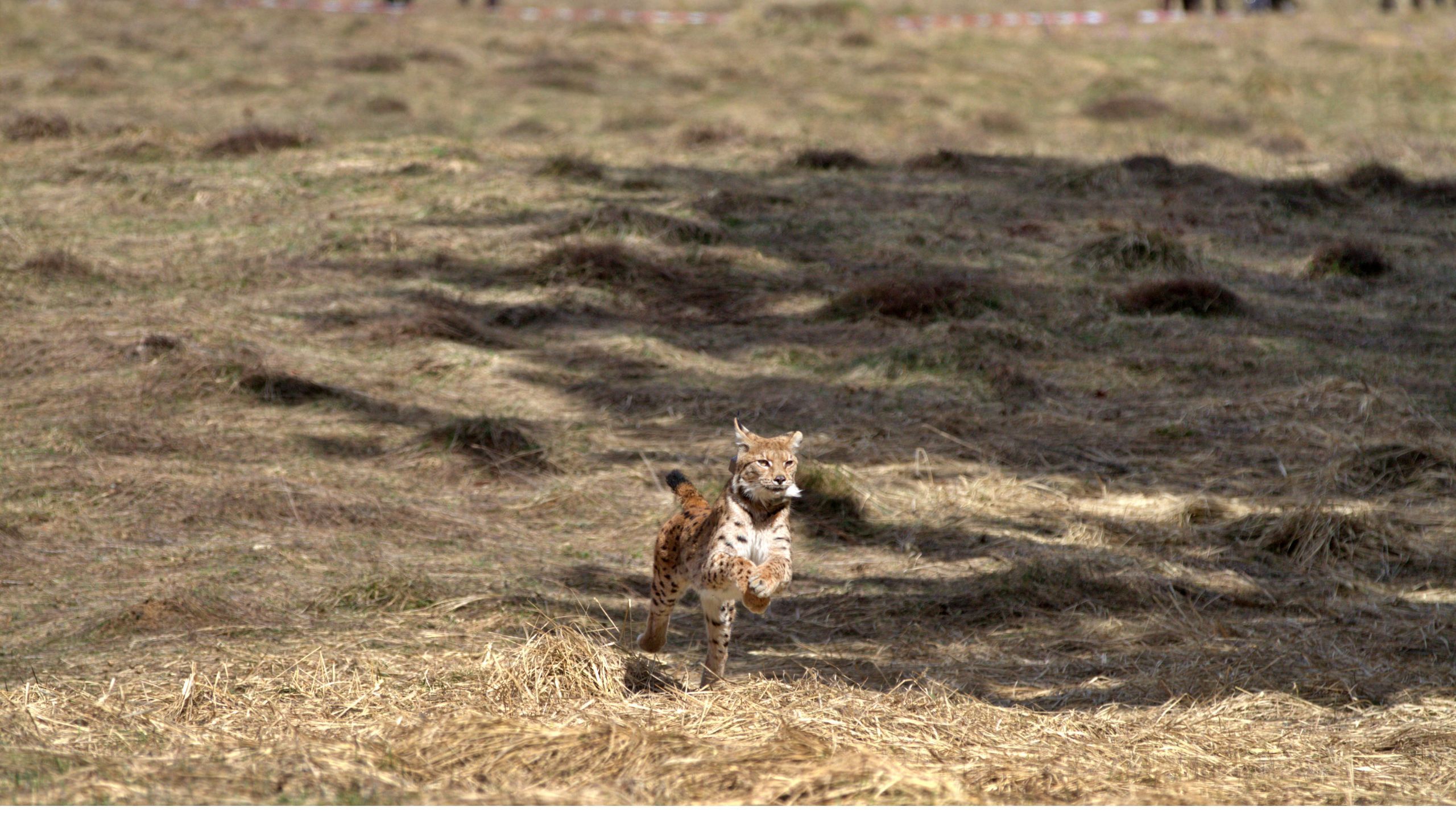The Last Lynx Release in Plitvice, Captured From Above
We spoke to the project LIFE Lynx, whose multi-year project includes releasing lynx in parts of Croatia and Slovenia to save the dwindling population from inbreeding.
Apr 06, 2023

The lynx Kras hops towards the forest after he is released in Plitvice Lakes National Park. ©Vedran Slijepčević
 By Rebecca Duras
By Rebecca Duras
On Friday, March 24th, 2023, Croatia’s famous Plitvice Lakes National Park received an unusual new visitor. His name is Kras, he comes from Romania, and unlike the many tourists that visit each year, he is in Plitvice hopefully to stay. That’s because Kras is a lynx.
Kras was released in Plitvice Lakes National Park as part of the project LIFE Lynx, which aims to protect the lynx population in the Dinaric and Southeast Alpine regions of Slovenia and Croatia. We spoke to Magda Sindičić, an associate professor at the Faculty of Veterinary Medicine University of Zagreb and a member of the project team. Amazing Aerial CEO Paul Prescott also had the opportunity to attend the lynx release in person and capture drone footage.
Why Kras Was Released In Plitvice
Kras was originally captured in the Carpathian Mountains of Romania, which has a well-established lynx population, then held in quarantine for two months before he was released in Plitvice Lakes National Park. He is the sixth and final lynx to be released in Croatia as part of LIFE Lynx’s project.
LIFE Lynx’s goal is to save the lynx population in the region. The project is not the first time that lynx were reintroduced in Croatia and Slovenia. After hunting and habitat loss ruined the lynx population in the early 20th century, lynx were reintroduced in Slovenia in 1973, exactly half a century ago. However, Magda Sindičić explains that after 50 years, the lynx population in the region became inbred since all the animals in the area were descendants of the six (closely related) specimens released earlier. The result was a declining population with a higher frequency of genetic diseases.
To combat this problem, LIFE Lynx released 16 lynx in total in Croatia and Slovenia (there were originally supposed to be 14, but the project lost contact with two animals, which is strong evidence that they died).
Kras was released in Plitvice Lakes National Park for a reason. “The northern part of Lika was not covered with these new genes so that is why we released the lynx here,” Sindičić explains. Plitvice Lakes also went four years without recording lynx reproduction, although a female lynx was spotted with young cubs this year. The hope is that adding a male lynx of reproductive age will help change that trend.
The care taken with choosing the right location to release Kras shows just how much work goes on below the surface to execute such a complex scientific project. “Releasing the lynx is just the cherry on top,” Sindičić says, explaining the additional work the LIFE Lynx team executed to complete the project. Besides capturing, quarantining, and releasing the lynx, the international team of experts tracks the lynx with telemetry collars, photo traps, and non-invasive DNA sampling. Even before the LIFE Lynx project was launched, the team conducted extensive sociological studies about the level of knowledge and support for the lynx population among locals, especially key stakeholders such as hunters.
What the New Lynx Mean for the Population in Croatia and Slovenia

An aerial image of Plitvice Lakes National Park. © Amazing Aerial Agency / Julien Duval
Sindičić is measured when evaluating the success of the project. “We hope that these animals will solve the problem of closely related animals mating and low genetic diversity, " she explains, “but long-term, if the population does not connect with the ones in the Alps or further south in Macedonia, reintroduction will be necessary again.” Habitat loss means that lynx populations are confined to smaller, isolated areas, which increases inbreeding.
More than other animals, lynx need well-preserved forests and habitats to survive. “They have to live in highly preserved areas, in preserved forests that have not been disturbed by humans,” Sindičić explains, “their very presence is an indicator of how well preserved a habitat is.”
Lynx feed on even-toed ungulates, which in Croatia and Slovenia means they primarily feed on roe deer. A healthy lynx population actually means a healthy population for their prey as well. Without lynx and other predators, deer population density increases which might affect the forest quality. Lynx also primarily feed on older, weaker, and sick individuals, which helps to purge the herd of diseased specimens. Sindičić tells us that healthy predator populations help stop the spread of zoonotic diseases.
Sindičić is quick to clarify that LIFE Lynx are scientists, not activists, and that their work is based on scientific analysis. “Protecting the environment is an interdisciplinary sphere where we have everyone, from activists to experts from different fields,” she elaborates.
For example, some of LIFE Lynx’s most valuable partners during their operation have been hunters. “Hunting is an integral part of wildlife management and a valuable tool for maintaining healthy biodiversity,” she explains, “they are not on the opposite side, we have common goals.” The project was well-supported by locals, including hunters, from the start, and would not have been possible without that support.
Capturing Kras’s First Steps in Plitvice

Kras is waved off to take his first steps in Plitvice Lakes National Park. Photo credit: Vedran Slijepčević
For Paul Prescott, the journey to flying a drone during the lynx release started when he met Tomislav Gomerčić, another LIFE Lynx member. He was originally planning to bring just a ground camera, but had just bought a new quiet drone. Paul was hesitant about disrupting the lynx, but a quick test flight proved that the new drone was really quiet enough to fly.
“It happened quite fast,” Paul says, describing the release. “It was quite well-planned where I was meant to be, I was not meant to be in front of where the lynx was supposed to run to scare it into a different direction,” he continues.
He captured the lynx’s first steps in Plitvice, following it from high above with the drone to avoid disturbing it and using a wide angle to make sure he included everything in the shot. “When I fly I normally just look at the screen, but this time I had to look with my own eyes to see the lynx, it was very beautiful,” Paul said. For him, it was an honor to be present when the last lynx as part of this project in Croatia was released and to learn about the project’s efforts.
During his visit, Paul also learned about the role of Plitvice Lakes National Park as a vital ecosystem. Although the park is most famous for its picturesque lakes and popular footpaths, it is an important habitat for hundreds of species, including sizable bear and wolf populations.
Even after Kras ventured into the forest, the work was not over. His role is to bring much-needed genetic diversity to the Dinaric lynx population. LIFE Lynx will continue monitoring the lynx population and use genetic modeling to give expert advice to the local government on maintaining a positive trend. Perhaps for photographers and videographers, the role in the interdisciplinary coalition working to save the environment is to raise awareness about the importance of initiatives such as this one.
Stay updated when we post new articles.
We hate SPAM. We will never sell your information, for any reason.








